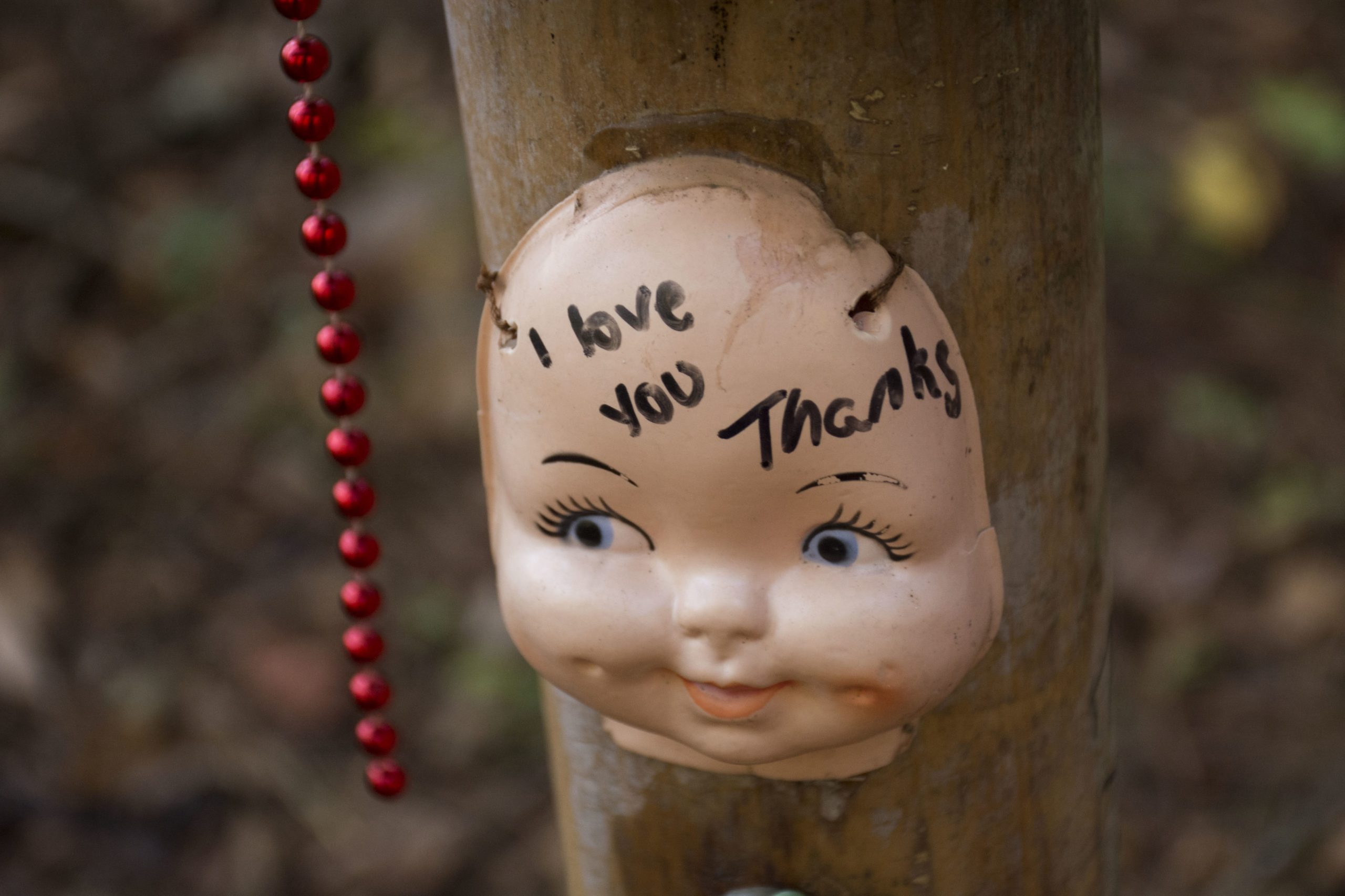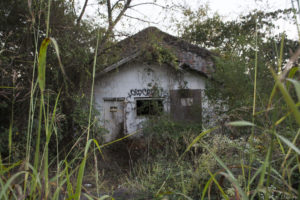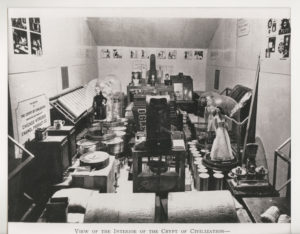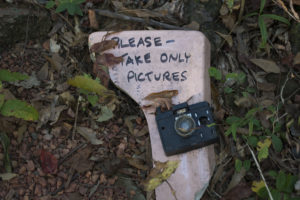
It’s hard to be original on Halloween.
Eventually, the old haunts just don’t seem as haunted as they did before. You’re over running from a teenager in a costume at Six Flag’s Fright Fest or waiting in line for hours at Netherworld in the cold.
This guide is for those people: the ones that want a real fright, and aren’t afraid to get a little dirty in the process. But take heed; these haunted destinations off of the beaten path are not for the lighthearted.
Doll’s Head Trail
Doll’s Head Trail is where childhoods go to die- literally.
Nestled deep in the heart of Constitution Lakes woods, abandoned and decayed baby dolls feel like the decay of childhood dreams. After a 21 minute hike through a thicket of overgrown trees and weeds, the first sign seen bearing a dirt encrusted baby doll head and the words “nobody puts baby in a corner” are almost welcoming. Then, you walk in.
It was like a creepy, angst filled museum exhibit. Kitschy, rusted clown figurines and baby doll heads are hung from tree branches like crude ornaments. There were clumsily drawn signs on trees, random lawn gnomes and other childhood artifacts, like action figures and toys. The counter clockwise field was a labyrinth of ideas and concepts: bricks bearing everything from the name and date of a visitor to Pink Floyd quotes.
THE HISTORY
According to atlasobscura.com, local Dekalb carpenter Joal Slaton was equal visionary and ecologist. Instead of the abandoned lands of South River Company, he saw a rural gem in an urban setting, and art where others saw litter. Every doll head, brick, random television set or rusted artifact are part of the washed up debris from floods. Slaton created an art project between him and the city of Atlanta; via a trailhead sign, all he asks is that everything be “found”.
The grounds to speak of were the former home of southern bricking company, South River Brick Company. When the company was shut down in the 1900s, the company’s clay pits that were once covered in Georgia’s famous red clay became habitually flooded. Part of Slaton’s vision was to use all of the random objects that washed up on the banks as part of the man-made lakes for Doll’s Head Trail.
Part the land of lost toys, part repurposed art and part urban decay- the Doll’s Head Trail is a well-rounded, decidedly haunted experience.
Old Prison Farm

Photo by Jade Johnson | The Signal
Right on the outskirts of Atlanta is an urban decay gem. After a fire in 2009, the Old Prison Farm is an ashtray of dilapidated buildings and crumbling cells. As if the fire is still burning, there is an acrid smell in the air.
But the air is also still; a vacuum where there should be evidence of human life, but there is none. The emaciated prison buildings sit as untouched as the day the prison was shut down, aside from the vandalism and stray animals. Otherwise, Mother Nature and Father Time have been its only visitors.
THE HISTORY
The former prison is located off of an equally abandoned road and across from mysterious fenced in acreage reminiscent of Area 51. Over the years, the grounds themselves have been swallowed up by nature; crumbling walls eaten up by ivy vines and devoured whole by the woods surrounding it. The first sight to greet visitors is a faded “Caution” sign, next to the blown out window of a sagging building. Trespassers should listen; only the brave (or reckless) should proceed.
According to www.atlasobscura.com, Atlanta’s Old Prison Farm was built in 1945 and housed thousands of inmates until their doors closed in 1995. The 400 acre grounds sat unused for over a decade, so when it caught fire in 2009, firefighters left it to burn.
Now all that remains are the blackened, supposedly haunted remnants. Like the Doll’s Head Trail, the Old Prison Farm itself has become repurposed art: the canvas for street murals and vivid graffiti.
The perfect backdrop for a photoshoot- just beware of ghosts and slipping into holes that lead to the generator house several feet below.
Editor’s Note: Trespassing into this property is illegal.
The Crypt of Civilization

1940.
Photo Submitted by
Oglethorpe University is hiding a piece of history- or should I say pieces?
In the 1940s, the then university president Dr. Thornwell Jacobs, had a vision to preserve and isolate a piece of history for the future; what we today call time capsules. Dubbed “the father of the modern time capsule”, Jacobs was both a professor who taught cosmic time and a student of time himself. According tocrypt.oglethorpe.edu.crypt.orglethorpe.edu, Jacobs was convinced that this “archeological duty” was his generation’s responsibility.
But until the time capsule is opened in 8113, all that is visible of the time capsule is the door: a mammoth stainless steel contraption that had to welded shut and bolted in. But the vault itself is the true scientific feat of Jacobs’ venture. Described as a “massive subterranean chamber” by Oglethorpe’s online records,crypt.oglethorpe.edu, the chamber weighs in at 20 feet long, 10 feet wide, and 10 feet high. The vault was designed to be impervious to aging; its granite walls, stone floors, and sealed receptacles filled with nitrogen render oxidation impossible.
Now, the basement where the vault is housed is home to a primary school. Visits are encouraged, but limited due to schooling.
With the vault’s inception, Jacobs accomplished the impossible: a vacuum where time truly does not exist.
THE HISTORY
Sealed on May 28, 1940, the crypt is a museum exhibit of 30s pop culture and contemporary technology up until that point. The artifacts within span centuries, and range from various cultures and time periods.
The crypt may be a stationary capsule located in the basement of Oglethorpe’s Phoebe Hearst Hall, but it has been featured in several publications. From The Guinness Book of World Records to the homegrown Atlanta Journal-Constitution, people around the world are eagerly awaiting the opening of those stainless steel doors.
“The crypt is testament to Oglethorpe’s history and personality, and it’s a legacy for President Jacobs who really helped to put Oglethorpe on the map,” Director of University Communications Renee Vary Keele said. “President Jacobs was a master at public relations, and the crypt not only helped put Oglethorpe on the map, but showed his passion for history and examining our place in time. Jacobs was a man before his time, literally.”
So this year, instead of getting lost in yet another corn maze, get lost in a creepy trail made of baby dolls, trespass on abandoned prison grounds and visit the crypt of Father Time. It will be a Halloween you won’t soon forget.
A Ghostbuster’s kind of road trip
Atlanta is home to a few haunted sites, but outside the city limits are where the truly haunted sites exist. From the cemeteries of Savannah to the markets of Antebellum Augusta, these supernatural landmarks are worth the drive, and then some.
Just make sure you buckle up; it might be a rough one.
Augusta’s Haunted Pillar
This historic monument may seem docile, but it is anything but innocent.
According to roadsideamerica.com, its origins date back to the downtown Augusta Lower Market that ran during the 1830s. But that’s where the certainty of its history stops. Rumors run amuck amongst the locals; some say that the pillar was a whipping post and the Lower Market was a slave market. Others say that the pillar came to be cursed by an irate preacher who prophesied that the market would be destroyed, but that the pillar would be the only thing left standing. Some say a voodoo princess cast a spell on it. Either way, according to hankeringforhistory.com, when a freak tornado blew through the town’s market in 1878, only the pillar remained.
Throughout the centuries, a few unlucky souls have attempted to move it, dying by random tragedy each time; struck by lightning, ran over by their own bulldozers. And today, the urban legend remains that if anyone is to touch the pillar, they’ll die. So visit if you’d like, but proceed with caution.
This offbeat site is located in downtown Augusta at 214 Fifth St. The pillar itself is at the edge of the parking lot for the store The Source.
The grave of Corinne Elliot Lawton
This one is a few hours out, but you won’t regret making this creepy graveyard a pit stop. Located in the heart of downtown Savannah, a beach town with strong historical roots in voodoo, the final resting place of Corinne Lawton is as mysterious as her death.
According to www.atlasobscura.com, the wealthy socialite fell in love with a man of lower stature, but was betrothed to a wealthier man of her parents’ choice. Legend has it that on the eve before her wedding, Corinne was so overcome with grief that she rode her father’s horse into the river. Her parents not only buried her, but had a statue erected after her in the cemetery.
The statue itself may be the creepiest part: it has no pupils, her garland has fallen from your head and her expression is so morose it’s almost lifelike. Her statue is positioned across from one of Jesus, but has her back to her family’s plot; her final act of rebellion.
Booger Hill
For this stop, you don’t even have to drive. Put the car in neutral, and supernatural forces will do all the work for you.
A Cumming urban legend, Booger Hill is an infamous incline where the ghosts of former slaves are rumored to push your car up the hill- and have even been known to leave handprints.
The hill is in between two giant oak trees, and according to www.hauntedinternet.com, those two trees were where the two slaves were hung. Eventually, their bodies were removed and said to be buried somewhere in the vicinity- but their spirits remain, restless and waiting for their next victim.
Crybaby Bridge
Deep in Columbus country, on Whitesville road, there is said be a mysterious woman in white who sometimes appears walking along the road. That same mysterious woman, is rumored to be a mother who drowned her baby in the neighboring creek many years ago. According to www.thehauntedhighway.tripod.com, Columbus natives claim that if you turn off your car, you can hear the sounds of a baby crying. But beware- your car is also rumored to not start back up.



